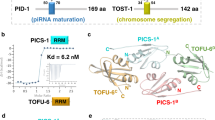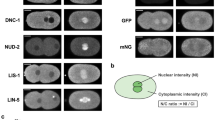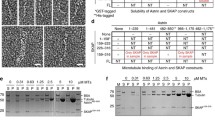Abstract
Spindle pole body (SPB; the microtubule organizing center in yeast) duplication is essential to form a bipolar spindle. The duplicated SPBs must then separate and migrate to opposite sides of the nucleus. We identified a novel functional relationship in SPB separation between the microtubule stabilizing protein Bik1p/CLIP-170 and the SPB half-bridge protein Sfi1p. A genetic interaction between BIK1 and SFI1 was discovered in a synthetic lethal screen using a strain deficient in the prion protein gene RNQ1. RNQ1 deletion reduced expression from the divergently transcribed BIK1, allowing us to identify genetic interactors with bik1. The sfi1-1 bik1 synthetic lethality was suppressed by over-expression of CIK1, KAR1, and PPH21. Genetic analysis indicated that the sfi1-1 bik1 synthetic lethality was unlikely related to the function of Bik1p in the dynein pathway or to defects in spindle position. Furthermore, a sfi1-1 Δkip2 mutant was viable, suggesting that the Bik1p pool at the cytoplasmic microtubule plus-ends may not be required in sfi1-1. Microscopic examination indicated the sfi1-1 mutant was delayed in SPB duplication, SPB separation, or spindle elongation and the sfi-1 Δbik1 double mutant arrested with duplicated but unseparated SPBs. These results suggest that Bik1p has a previously uncharacterized function in the separation of duplicated SPBs.







Similar content being viewed by others
References
Adames NR, Cooper JA (2000) Microtubule interactions with the cell cortex causing nuclear movements in Saccharomyces cerevisiae. J Cell Biol 149:863–874
Adams IR, Kilmartin JV (2000) Spindle pole body duplication: a model for centrosome duplication? Trends Cell Biol 10:329–335
Barrett JG, Manning BD, Snyder M (2000) The Kar3p kinesin-related protein forms a novel heterodimeric structure with its associated protein Cik1p. Mol Biol Cell 11:2373–2385
Baudin A, Ozier-Kalogeropoulos O, Denouel A, Lacroute F, Cullin C (1993) A simple and efficient method for direct gene deletion in Saccharomyces cerevisiae. Nucleic Acids Res 21:3329–3330
Beach DL, Thibodeaux J, Maddox P, Yeh E, Bloom K (2000) The role of the proteins Kar9 and Myo2 in orienting the mitotic spindle of budding yeast. Curr Biol 10:1497–1506
Begley TJ, Rosenbach AS, Ideker T, Samson LD (2002) Damage recovery pathways in Saccharomyces cerevisiae revealed by genomic phenotyping and interactome mapping. Mol Cancer Res 1:103–112
Bennett CB et al (2001) Genes required for ionizing radiation resistance in yeast. Nat Genet 29:426–434
Berlin V, Styles CA, Fink GR (1990) BIK1, a protein required for microtubule function during mating and mitosis in Saccharomyces cerevisiae, colocalizes with tubulin. J Cell Biol 111:2573–2586
Bianchi MM et al (1999) How to bring orphan genes into functional families. Yeast 15:513–526
Biggins S, Rose MD (1994) Direct interaction between yeast spindle pole body components: Kar1p is required for Cdc31p localization to the spindle pole body. J Cell Biol 125:843–852
Brachmann CB et al (1998) Designer deletion strains derived from Saccharomyces cerevisiae S288C: a useful set of strains and plasmids for PCR-mediated gene disruption and other applications. Yeast 14:115–132
Byers B, Goetsch L (1974) Duplication of spindle plaques and integration of the yeast cell cycle. Cold Spring Harb Symp Quant Biol 38:123–131
Byers B, Goetsch L (1975) Behavior of spindles and spindle plaques in the cell cycle and conjugation of Saccharomyces cerevisiae. J Bacteriol 124:511–523
Byers B, Goetsch L (1991) Preparation of yeast cells for thin-section electron microscopy. Methods Enzymol 194:602–608
Carvalho P, Gupta ML Jr, Hoyt MA, Pellman D (2004) Cell cycle control of kinesin-mediated transport of Bik1 (CLIP-170) regulates microtubule stability and dynein activation. Dev Cell 6:815–829
Chen RH, Brady DM, Smith D, Murray AW, Hardwick KG (1999) The spindle checkpoint of budding yeast depends on a tight complex between the Mad1 and Mad2 proteins. Mol Biol Cell 10:2607–2618
Choi JH, Adames NR, Chan TF, Zeng C, Cooper JA, Zheng XF (2000) TOR signaling regulates microtubule structure and function. Curr Biol 10:861–864
Christianson TW, Sikorski RS, Dante M, Shero JH, Hieter P (1992) Multifunctional yeast high-copy-number shuttle vectors. Gene 110:119–122
Cottingham FR, Gheber L, Miller DL, Hoyt MA (1999) Novel roles for Saccharomyces cerevisiae mitotic spindle motors. J Cell Biol 147:335–350
Cottingham FR, Hoyt MA (1997) Mitotic spindle positioning in Saccharomyces cerevisiae is accomplished by antagonistically acting microtubule motor proteins. J Cell Biol 138:1041–1053
Daniel JA, Keyes BE, Ng YP, Freeman CO, Burke DJ (2006) Diverse functions of spindle assembly checkpoint genes in Saccharomyces cerevisiae. Genetics 172:53–65
DeZwaan TM, Ellingson E, Pellman D, Roof DM (1997) Kinesin-related KIP3 of Saccharomyces cerevisiae is required for a distinct step in nuclear migration. J Cell Biol 138:1023–1040
Fitch I et al (1992) Characterization of four B-type cyclin genes of the budding yeast Saccharomyces cerevisiae. Mol Biol Cell 3:805–818
Geiser JR et al (1997) Saccharomyces cerevisiae genes required in the absence of the CIN8-encoded spindle motor act in functionally diverse mitotic pathways. Mol Biol Cell 8:1035–1050
Giaever G et al (2002) Functional profiling of the Saccharomyces cerevisiae genome. Nature 418:387–391
Goldstein AL, McCusker JH (1999) Three new dominant drug resistance cassettes for gene disruption in Saccharomyces cerevisiae. Yeast 15:1541–1553
He X, Rines DR, Espelin CW, Sorger PK (2001) Molecular analysis of kinetochore-microtubule attachment in budding yeast. Cell 106:195–206
Heil-Chapdelaine RA, Oberle JR, Cooper JA (2000) The cortical protein Num1p is essential for dynein-dependent interactions of microtubules with the cortex. J Cell Biol 151:1337–1344
Helfant AH (2002) Composition of the spindle pole body of Saccharomyces cerevisiae and the proteins involved in its duplication. Curr Genet 40:291–310
Hoyt MA, He L, Loo KK, Saunders WS (1992) Two Saccharomyces cerevisiae kinesin-related gene products required for mitotic spindle assembly. J Cell Biol 118:109–120
Huh WK et al (2003) Global analysis of protein localization in budding yeast. Nature 425:686–691
Huyett A, Kahana J, Silver P, Zeng X, Saunders WS (1998) The Kar3p and Kip2p motors function antagonistically at the spindle poles to influence cytoplasmic microtubule numbers. J Cell Sci 111(Pt 3):295–301
Jacobs CW, Adams AE, Szaniszlo PJ, Pringle JR (1988) Functions of microtubules in the Saccharomyces cerevisiae cell cycle. J Cell Biol 107:1409–1426
Jaspersen SL, Giddings TH Jr, Winey M (2002) Mps3p is a novel component of the yeast spindle pole body that interacts with the yeast centrin homologue Cdc31p. J Cell Biol 159:945–956
Jaspersen SL, Winey M (2004) The budding yeast spindle pole body: structure, duplication, and function. Annu Rev Cell Dev Biol 20:1–28
Kahana JA, Schnapp BJ, Silver PA (1995) Kinetics of spindle pole body separation in budding yeast. Proc Natl Acad Sci USA 92:9707–9711
Kilmartin JV (2003) Sfi1p has conserved centrin-binding sites and an essential function in budding yeast spindle pole body duplication. J Cell Biol 162:1211–1221
Koren A, Ben-Aroya S, Steinlauf R, Kupiec M (2003) Pitfalls of the synthetic lethality screen in Saccharomyces cerevisiae: an improved design. Curr Genet 43:62–69
Kusch J, Liakopoulos D, Barral Y (2003) Spindle asymmetry: a compass for the cell. Trends Cell Biol 13:562–569
Lawrence CW (1991) Classical mutagenesis techniques. Methods Enzymol 194:273–281
Lee L, Tirnauer JS, Li J, Schuyler SC, Liu JY, Pellman D (2000) Positioning of the mitotic spindle by a cortical-microtubule capture mechanism. Science 287:2260–2262
Li R, Murray AW (1991) Feedback control of mitosis in budding yeast. Cell 66:519–531
Li S, Sandercock AM, Conduit P, Robinson CV, Williams RL, Kilmartin JV (2006) Structural role of Sfi1p-centrin filaments in budding yeast spindle pole body duplication. J Cell Biol 173:867–877
Lim HH, Goh PY, Surana U (1996) Spindle pole body separation in Saccharomyces cerevisiae requires dephosphorylation of the tyrosine 19 residue of Cdc28. Mol Cell Biol 16:6385–6397
Lin H et al (2001) Polyploids require Bik1 for kinetochore-microtubule attachment. J Cell Biol 155:1173–1184
Liu H, Krizek J, Bretscher A (1992) Construction of a GAL1-regulated yeast cDNA expression library and its application to the identification of genes whose overexpression causes lethality in yeast. Genetics 132:665–673
Ma P et al (1999) Deletion of SFI1, a novel suppressor of partial Ras-cAMP pathway deficiency in the yeast Saccharomyces cerevisiae, causes G(2) arrest. Yeast 15:1097–1109
Manning BD, Barrett JG, Wallace JA, Granok H, Snyder M (1999) Differential regulation of the Kar3p kinesin-related protein by two associated proteins, Cik1p and Vik1p. J Cell Biol 144:1219–1233
McCarthy EK, Goldstein B (2006) Asymmetric spindle positioning. Curr Opin Cell Biol 18:79–85
Miller RK et al (1998) The kinesin-related proteins, Kip2p and Kip3p, function differently in nuclear migration in yeast. Mol Biol Cell 9:2051–2068
Miller RK, Rose MD (1998) Kar9p is a novel cortical protein required for cytoplasmic microtubule orientation in yeast. J Cell Biol 140:377–390
Moore JK, D’Silva S, Miller RK (2006) The CLIP-170 homologue Bik1p promotes the phosphorylation and asymmetric localization of Kar9p. Mol Biol Cell 17:178–191
Muhua L, Karpova TS, Cooper JA (1994) A yeast actin-related protein homologous to that in vertebrate dynactin complex is important for spindle orientation and nuclear migration. Cell 78:669–679
Mumberg D, Muller R, Funk M (1994) Regulatable promoters of Saccharomyces cerevisiae: comparison of transcriptional activity and their use for heterologous expression. Nucleic Acids Res 22:5767–5768
Newman JR, Wolf E, Kim PS (2000) A computationally directed screen identifying interacting coiled coils from Saccharomyces cerevisiae. Proc Natl Acad Sci USA 97:13203–13208
Orlowska-Matuszewska G, Wawrzycka D (2006) A novel phenotype of eight spores asci in deletants of the prion-like Rnq1p in Saccharomyces cerevisiae. Biochem Biophys Res Commun 340:190–193
Page BD, Satterwhite LL, Rose MD, Snyder M (1994) Localization of the Kar3 kinesin heavy chain-related protein requires the Cik1 interacting protein. J Cell Biol 124:507–519
Page BD, Snyder M (1992) CIK1: a developmentally regulated spindle pole body-associated protein important for microtubule functions in Saccharomyces cerevisiae. Genes Dev 6:1414–1429
Parsons AB et al (2004) Integration of chemical-genetic and genetic interaction data links bioactive compounds to cellular target pathways. Nat Biotechnol 22:62–69
Pearson CG, Bloom K (2004) Dynamic microtubules lead the way for spindle positioning. Nat Rev Mol Cell Biol 5:481–492
Pellman D, Bagget M, Tu YH, Fink GR, Tu H (1995) Two microtubule-associated proteins required for anaphase spindle movement in Saccharomyces cerevisiae. J Cell Biol 130:1373–1385
Pierre P, Scheel J, Rickard JE, Kreis TE (1992) CLIP-170 links endocytic vesicles to microtubules. Cell 70:887–900
Ronne H, Carlberg M, Hu GZ, Nehlin JO (1991) Protein phosphatase 2A in Saccharomyces cerevisiae: effects on cell growth and bud morphogenesis. Mol Cell Biol 11:4876–4884
Roof DM, Meluh PB, Rose MD (1992) Kinesin-related proteins required for assembly of the mitotic spindle. J Cell Biol 118:95–108
Rose MD, Fink GR (1987) KAR1, a gene required for function of both intranuclear and extranuclear microtubules in yeast. Cell 48:1047–1060
Salisbury JL (2004) Centrosomes: Sfi1p and centrin unravel a structural riddle. Curr Biol 14:R27–R29
Saunders W, Lengyel V, Hoyt MA (1997) Mitotic spindle function in Saccharomyces cerevisiae requires a balance between different types of kinesin-related motors. Mol Biol Cell 8:1025–1033
Saunders WS, Hoyt MA (1992) Kinesin-related proteins required for structural integrity of the mitotic spindle. Cell 70:451–458
Schramm C, Elliott S, Shevchenko A, Schiebel E (2000) The Bbp1p-Mps2p complex connects the SPB to the nuclear envelope and is essential for SPB duplication. Embo J 19:421–433
Schuyler SC, Liu JY, Pellman D (2003) The molecular function of Ase1p: evidence for a MAP-dependent midzone-specific spindle matrix. Microtubule-associated proteins. J Cell Biol 160:517–528
Schwartz K, Richards K, Botstein D (1997) BIM1 encodes a microtubule-binding protein in yeast. Mol Biol Cell 8:2677–2691
Sheeman B et al (2003) Determinants of S. cerevisiae dynein localization and activation: implications for the mechanism of spindle positioning. Curr Biol 13:364–372
Sikorski RS, Hieter P (1989) A system of shuttle vectors and yeast host strains designed for efficient manipulation of DNA in Saccharomyces cerevisiae. Genetics 122:19–27
Sneddon AA, Cohen PT, Stark MJ (1990) Saccharomyces cerevisiae protein phosphatase 2A performs an essential cellular function and is encoded by two genes. Embo J 9:4339–4346
Sondheimer N, Lindquist S (2000) Rnq1: an epigenetic modifier of protein function in yeast. Mol Cell 5:163–172
Spang A, Courtney I, Fackler U, Matzner M, Schiebel E (1993) The calcium-binding protein cell division cycle 31 of Saccharomyces cerevisiae is a component of the half bridge of the spindle pole body. J Cell Biol 123:405–416
Spang A, Courtney I, Grein K, Matzner M, Schiebel E (1995) The Cdc31p-binding protein Kar1p is a component of the half bridge of the yeast spindle pole body. J Cell Biol 128:863–877
Sullivan DS, Biggins S, Rose MD (1998) The yeast centrin, Cdc31p, and the interacting protein kinase, Kic1p, are required for cell integrity. J Cell Biol 143:751–765
Tanaka K et al (2005) Molecular mechanisms of kinetochore capture by spindle microtubules. Nature 434:987–994
Tirnauer JS, O’Toole E, Berrueta L, Bierer BE, Pellman D (1999) Yeast Bim1p promotes the G1-specific dynamics of microtubules. J Cell Biol 145:993–1007
Tong AH et al (2001) Systematic genetic analysis with ordered arrays of yeast deletion mutants. Science 294:2364–2368
Tong AH et al (2004) Global mapping of the yeast genetic interaction network. Science 303:808–813
Ubersax JA et al (2003) Targets of the cyclin-dependent kinase Cdk1. Nature 425:859–864
Wach A, Brachat A, Pohlmann R, Philippsen P (1994) New heterologous modules for classical or PCR-based gene disruptions in Saccharomyces cerevisiae. Yeast 10:1793–1808
Wente SR, Blobel G (1993) A temperature-sensitive NUP116 null mutant forms a nuclear envelope seal over the yeast nuclear pore complex thereby blocking nucleocytoplasmic traffic. J Cell Biol 123:275–284
Wolyniak MJ, Blake-Hodek K, Kosco K, Hwang E, You L, Huffaker TC (2006) The regulation of microtubule dynamics in Saccharomyces cerevisiae by three interacting plus-end tracking proteins. Mol Biol Cell 17:2789–2798
Yeh E et al (2000) Dynamic positioning of mitotic spindles in yeast: role of microtubule motors and cortical determinants. Mol Biol Cell 11:3949–3961
Zieler HA, Walberg M, Berg P (1995) Suppression of mutations in two Saccharomyces cerevisiae genes by the adenovirus E1A protein. Mol Cell Biol 15:3227–3237
Acknowledgments
We gratefully acknowledge Marissa Matsumoto for initiating the synthetic lethal screen, Sarah Broekelmann for technical support, Larry Schriefer for assistance with DNA sequencing, and Howard Wynder for assistance with EM. We thank Anthony Bretscher, John Cooper, John Kilmartin, Martin Kupiec, Susan Lindquist, Rita Miller, and Mark Rose for sharing plasmids, strains, antibodies, libraries, and equipment. We are grateful to John Cooper, Jun Li, Scott Nelson, Mark Winey, and members of the True lab for helpful discussions. We thank Rachel Boutenott, Jun Li, and Scott Nelson for providing critical comments on the manuscript. This work was supported by funds from National Institutes of Health Grant AG024560, the Edward Mallinckrodt Jr. Foundation, and the Ellison Medical Foundation (awarded to H.L.T.). L.A.S. was supported by a fellowship from the Washington University Infectious Diseases Scholars Program (National Institutes of Health Ruth L. Kirschstein National Research Service Award Training Grant T32 A107172-25) and a USDA National Research Initiative Postdoctoral AREA Award (2005-35201-15383).
Author information
Authors and Affiliations
Corresponding author
Additional information
Communicated by M. Kupiec.
Rights and permissions
About this article
Cite this article
Strawn, L.A., True, H.L. Deletion of RNQ1 gene reveals novel functional relationship between divergently transcribed Bik1p/CLIP-170 and Sfi1p in spindle pole body separation. Curr Genet 50, 347–366 (2006). https://doi.org/10.1007/s00294-006-0098-6
Received:
Revised:
Accepted:
Published:
Issue Date:
DOI: https://doi.org/10.1007/s00294-006-0098-6




